How to Pressure Can Pinto Beans
This one of those things that might not seem worth the trouble, but it really is. Dried beans are so affordable, but take forever. But when you pressure can your own pinto beans, they’re ready to go.
You’ll love these in chili, casseroles, or as a side. It’s one of the most practical pressure canning recipes.
Pressure Canning Pinto Beans Recipe

Equipment
- Large Pot 8-10 quart
- strainer
- Canning funnel
- Wooden Chopstick
- jars
- lids and rings
- Jar lifter
- magnetic lid lifter
Ingredients
- 2 pounds of dried pinto beans soaked overnight
- 3 teaspoon canning salt
- water
- white vinegar (optional)
Save This Recipe
You'll join my email list which you will love. And if you don't, unsubscribe in one click. ❤️
Instructions
- Soak beans. The night before, soak the beans in cool water.
- Drain and rinse beans. Drain and rinse the soaked pinto beans. Transfer them into a large pot (8-10 quart).
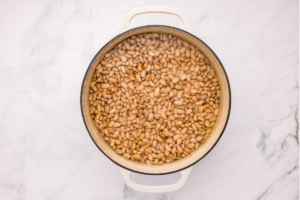
- Cook beans. Add enough water to the pot so the beans are covered with water plus 2 inches. Place over medium heat and allow the beans to come to a boil. Cover and reduce the heat to low and allow to simmer for 30 minutes.

- Prep canner. Prepare your pressure canner by adding the rack and 3 inches of water to the pot (or follow your manufacturer's recommendations). Add 2 tbsp of white vinegar (this prevents mineral deposits from collecting on the jars). Place over medium heat and allow it to come to a gentle boil.
- Prep jars and rings. Place the canning jars and rings in a pot with hot water and allow to simmer (no boil). Wash the jars with hot soapy water. Fill them with hot water preparing them to be filled with hot beans.
- Drain beans. Once the beans have simmered for 30 minutes, drain them and set aside.
- Prep hot water. Bring a pot of water to a boil. (This will be for filling jars later)
- Fill jars with beans. Drain the jars of the hot water. Using a funnel and ladle, fill the jars with beans leaving a 1-inch head space. Top with 1 tsp of salt if using quart jars or ½ tsp of salt if using pint jars. Fill the jars with fresh hot water leaving a 1-inch headspace. Using a wooden chopstick or plastic knife, remove as much air and bubbles as you can. Refilling with water so there’s a consistent 1-inch headspace.

- Place lids on top. Place the lids and rings onto the jars.

- Process in pressure canner. Using a jar lifter, place the jars into the pressure canner making sure there’s enough space between jars. Place the lid on the canner, confirming a proper seal. Cook on high heat until a steady stream of steam is being released. Allow the steam to vent for 10 minutes. Set your gauge to 10 and allow the canner to come to 11 lbs of pressure. Once it hits 11 lbs of pressure, set the timer for 75 minutes for pint-sized jars or 90 minutes for quart-sized jars, and adjust for altitude. Continue to monitor the pressure so it doesn’t go below 11 lbs of pressure Turn off the heat and allow the pressure gauge to hit zero before releasing the steam.

- Release pressure. When the time is up, turn off the heat and allow the pressure gauge to hit zero before releasing the steam. Release the steam and carefully remove the lid, tilting the lid away from you so the steam doesn’t hit your face.
- Rest jars before removing. Allow the jars to sit for 10-15 minutes before removing them from the canner.

- Cool and check seals. Place the jars on a cooling rack and allow them to cool overnight. Check for a seal after 24 hours. Immediately use any unsealed jars and store the properly sealed jars for up to 18 months. (check your lid’s manufacturer’s recommendations for storing.)
Notes
Nutrition
I really like having pinto beans on hand for busy weeknights when I need a quick and healthy meal. I can’t count how many times these beans have saved dinner, whether I’m making a hearty chili, a fresh salad, or a quick bean dip. It’s so much easier to grab a jar than to run to the store when I’m pressed for time.
A Newsletter you’ll love
Daily recipes from the farmhouse, Sunday meal plans, seasonal ideas, straight from my kitchen to your inbox.
I promise to keep your email address safe. Unsubscribe at any time

I hope you enjoy these and that they help you as much as they help me!
Key Ingredients and Tools

Canning Salt. This salt is pure and free from additives, ensuring your beans don’t end up cloudy or with off-flavors.
Pressure Canner. Essential for safely canning low-acid foods like beans, a pressure canner maintains the high temperature needed to kill bacteria.
Canning Funnel. Helps you fill jars without making a mess, making the process smoother and cleaner.
Magnetic Lid Lifter. Makes handling hot lids easy and safe, preventing burns and contamination.
Wooden Chopstick. Perfect for removing air bubbles from the filled jars, ensuring a proper seal.
Troubleshooting and Help
Absolutely! Soaking the beans overnight helps to soften them and reduce cooking time. It also helps to remove some of the indigestible sugars that can cause gas. Trust me, it’s worth the extra step.
You could, but I wouldn’t recommend it. Table salt has additives that can make your beans look cloudy. Canning salt is pure and gives the best results.
Great question! If you’re above 1,000 feet, you’ll need to increase the pressure. Check your pressure canner’s manual for specific instructions. It’s really important to get this right for safety.
No worries! If a jar doesn’t seal, just pop it in the fridge and use it within a week. You can also reprocess it with a new lid, following the same canning steps.
Yes, but be cautious. Stick to small amounts of dried herbs and spices to avoid altering the pH. Avoid adding fats or oils as they can affect the sealing process.
This is a great way to make sure I always have a healthy and flexible ingredient on hand. The process is straightforward and manageable and I can make a lot with just a little effort. I hope you enjoy making this and that you find a new addition to your pantry.

Love,


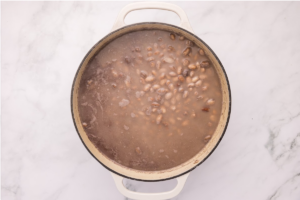
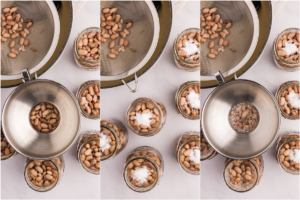
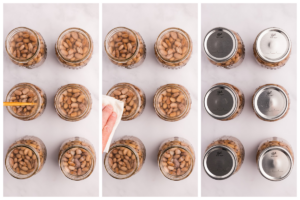
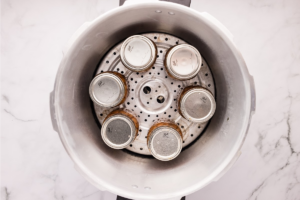
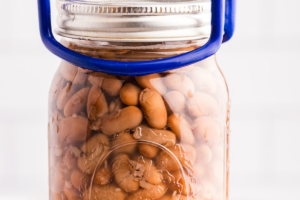









Your beans look wonderful but why can you not can them in the water they were cooked in and how do you season these when your ready to eat them?
Hi Sheree the flavor is better if you can them in fresh water. I use them usually in burritos or chili, but you can also cook them into refried beans very easily. I don’t really eat them plain.